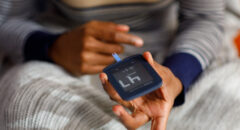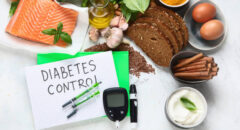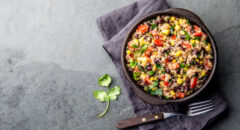
Bread has gotten a bad reputation because of various diet fads: no-carb, gluten-free, paleo, etc. It’s been vilified as the cause for everything from weight gain, to inflammation, to diabetes, to digestion issues…the list goes on and on. The truth is, bread can cause weight gain and other issues, but does that mean you shouldn't eat it at all? NO!
YOU MAY ALSO LIKE: Top 10 Filling Foods For Weight Loss
I don't know about you, but bread tastes good and goes great with a little meat and cheese in between two slices. So don't give up on bread, just eat the kind of bread that's best for you. But first, here's what kind of bread to not eat.
Ingredients to ALWAYS Avoid:
- Anything white
- Anything with “enriched,” “bleached,” or “unbleached” as part of the first ingredient. “Enriched wheat” = “White”
Be wary of “wheat” or even “100% whole wheat” — some breads will have this as an ingredient but are still highly processed and refined - Anything with less than 2g fiber per serving
- Anything with raisins, dried fruits, cinnamon, banana, honey, or vanilla listed on the packaging
- Dough conditioners (like azodicarbonamide, DATEM, monoglycerides, diglycerides, sodium stearoyl lactylate): these are just chemicals added to the bread to make the bread making process faster and scalable to big batches. They’re not necessary for real bread, and if these ingredients are on the label, it’s a good sign that the bread isn’t truly healthy.
- GMO ingredients: like soybean oil and corn oil (honestly, these are just not necessary to make bread)
- Preservatives (like calcium propionate): bread isn’t supposed to be able to last on the counter for 1-2 weeks without getting hard and moldy. If you see any ingredients you can’t pronounce, it’s likely a preservative so put the bread down and find another option.
- Added sugar: If your bread has yeast, it will likely have a tiny bit of honey or sugar because you need sugar to activate yeast. That being said, anything over 2g per slice is unnecessary. Watch out for high fructose corn syrup, any kind of syrup or artificial sweeteners added to bread. This is especially true for light breads.
Artificial flavors and coloring: Caramel coloring is often added to fake “wheat” breads to make them seem more brown. If you see this on the label, avoid that bread!
Here are some of the worst on the market right now:
1. Wonder Bread, Classic White
140 calories, 1.5 g fat (0 g saturated fat), 180 mg sodium, 29 g carbs (2 g fiber, 5 g sugar), 4 g protein
2. King's Hawaiian Sweet Rolls
90 calories, 2 g fat (1 g saturated fat), 80 mg sodium, 16 g carbs (0 g fiber, 5 g sugar), 3 g protein
3. Martin's Cinnamon Sugar Swirl Bread
80 calories, 1.5 g fat (0 g saturated fat), 105 mg sodium, 14 g carbs (1 g fiber, 4 g sugar), 3 g protein
4. Martin's Cinnamon-Raisin, Butter Bread
90 calories, <1 g fat (0 g saturated fat), 90 mg sodium, 17 g carbs <1 g fiber, 7 g sugar), 4 g protein
5. Martin's Potato Bread
90 calories, 1.5 g fat (0.5 g saturated fat), 105 mg sodium, 15 g carbs (1 g fiber, 3 g sugar), 3 g protein
6. Dave's Killer Bread, Raisin' The Roof
90 calories, 1.5 g fat (0 g saturated fat), 95 mg sodium, 17 g carbs (2 g fiber, 6 g sugar), 3 g protein
7. Vermont Bread Company, Wheat Cinnamon Raisin
YOU MAY ALSO LIKE: You'll Love This Butter Pecan Cornbread
Best Bread to Buy
Now, with that out of the way, here's what kind of bread to pick up the next time you're in the grocery store:
7. THOMAS' LIGHT ENGLISH MUFFINS
Outside of green vegetables, you’ll find very few foods that pack 8 grams of fiber into 100 calories. The best part? These lightened-up English Muffins taste nearly identical to the original, higher-cal variety, making them an unbeatable foundation for breakfast sandwiches.
6. PEPPERIDGE FARM 15 GRAIN
A sandwich made from this bread provides just under 25 percent of the day’s hunger-crushing fiber and 16 percent of the day's niacin, a vitamin that helps convert food to energy. (The easier your food converts to energy, the more quickly you’ll shed pounds!)
Plus, it’s free of high fructose corn syrup (HFCS), which is becoming a rarity in the bread aisle.
5. NATURE’S OWN WHEAT BREAD
Thanks to the addition of inulin, a natural fiber made from chicory, a sandwich made with this bread provides at least 40 percent of the day’s intake of the hunger-quelling fiber. It’s also a good source of protein (a nutrient not all breads are rich in), which can help you build muscle and keep your metabolism humming.
4. MISSION YELLOW CORN TORTILLAS
Well, we know they aren't technically bread, but these yellow corn tortillas are tasty. Most wraps are loaded with...
... soybean and hydrogenated oils—it’s what makes them so pliable and bendy. Toss them to the curb and restock your shelves with these fiber-rich corn tortillas. You’ll get a similar look and taste for a fraction of the fat.
YOU MAY ALSO LIKE: When Loving Bread Is Wrong & You Wanna Be Right
3. THOMAS' 100% WHOLE WHEAT BAGELS
These are one of the best bagels we’ve come across: They pack tons of heart-healthy fiber, plus 10 grams of weight loss-boosting protein in each serving.
Not to mention, they serve up 15 percent of the day’s thiamin, a vitamin that helps convert carbs to energy.
Translation: Fewer carbohydrates will lurk around and become stored as fat on your frame.
2. SANDWICH THINS
Sandwich Thins will help keep you, well, thin! Protein and fiber supply more than a third of these calories, which will keep you satisfied—not stuffed.
If you’re worried this low-cal lunchtime alternative won’t be enough to keep you full through the afternoon, add plenty of water-filled veggies.
1. Schmidt Old Tyme
When a company has existed for over a century, its got to be doing something right. Schmidt Baking Company is doing just that with their roots dating back to 1886.
Today, this food manufacturer emphasizes how it uses natural and wholesome ingredients in its products, including its breads.
The majority of their sliced breads are both low fat and cholesterol free.








